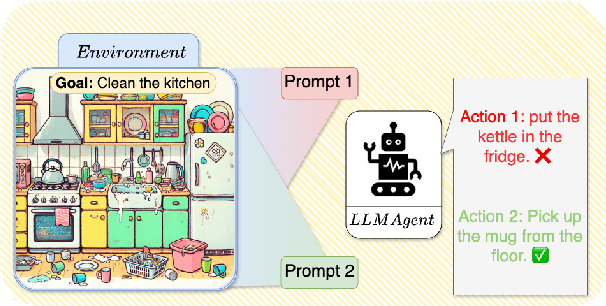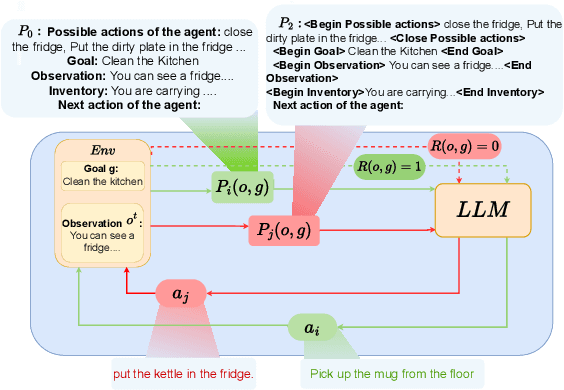Laure Soulier
Clarifying Ambiguities: on the Role of Ambiguity Types in Prompting Methods for Clarification Generation
Apr 16, 2025



Abstract:In information retrieval (IR), providing appropriate clarifications to better understand users' information needs is crucial for building a proactive search-oriented dialogue system. Due to the strong in-context learning ability of large language models (LLMs), recent studies investigate prompting methods to generate clarifications using few-shot or Chain of Thought (CoT) prompts. However, vanilla CoT prompting does not distinguish the characteristics of different information needs, making it difficult to understand how LLMs resolve ambiguities in user queries. In this work, we focus on the concept of ambiguity for clarification, seeking to model and integrate ambiguities in the clarification process. To this end, we comprehensively study the impact of prompting schemes based on reasoning and ambiguity for clarification. The idea is to enhance the reasoning abilities of LLMs by limiting CoT to predict first ambiguity types that can be interpreted as instructions to clarify, then correspondingly generate clarifications. We name this new prompting scheme Ambiguity Type-Chain of Thought (AT-CoT). Experiments are conducted on various datasets containing human-annotated clarifying questions to compare AT-CoT with multiple baselines. We also perform user simulations to implicitly measure the quality of generated clarifications under various IR scenarios.
VIPER: Visual Perception and Explainable Reasoning for Sequential Decision-Making
Mar 19, 2025Abstract:While Large Language Models (LLMs) excel at reasoning on text and Vision-Language Models (VLMs) are highly effective for visual perception, applying those models for visual instruction-based planning remains a widely open problem. In this paper, we introduce VIPER, a novel framework for multimodal instruction-based planning that integrates VLM-based perception with LLM-based reasoning. Our approach uses a modular pipeline where a frozen VLM generates textual descriptions of image observations, which are then processed by an LLM policy to predict actions based on the task goal. We fine-tune the reasoning module using behavioral cloning and reinforcement learning, improving our agent's decision-making capabilities. Experiments on the ALFWorld benchmark show that VIPER significantly outperforms state-of-the-art visual instruction-based planners while narrowing the gap with purely text-based oracles. By leveraging text as an intermediate representation, VIPER also enhances explainability, paving the way for a fine-grained analysis of perception and reasoning components.
SCOPE: A Self-supervised Framework for Improving Faithfulness in Conditional Text Generation
Feb 19, 2025Abstract:Large Language Models (LLMs), when used for conditional text generation, often produce hallucinations, i.e., information that is unfaithful or not grounded in the input context. This issue arises in typical conditional text generation tasks, such as text summarization and data-to-text generation, where the goal is to produce fluent text based on contextual input. When fine-tuned on specific domains, LLMs struggle to provide faithful answers to a given context, often adding information or generating errors. One underlying cause of this issue is that LLMs rely on statistical patterns learned from their training data. This reliance can interfere with the model's ability to stay faithful to a provided context, leading to the generation of ungrounded information. We build upon this observation and introduce a novel self-supervised method for generating a training set of unfaithful samples. We then refine the model using a training process that encourages the generation of grounded outputs over unfaithful ones, drawing on preference-based training. Our approach leads to significantly more grounded text generation, outperforming existing self-supervised techniques in faithfulness, as evaluated through automatic metrics, LLM-based assessments, and human evaluations.
Reinforcement Learning for Aligning Large Language Models Agents with Interactive Environments: Quantifying and Mitigating Prompt Overfitting
Oct 29, 2024



Abstract:Reinforcement learning (RL) is a promising approach for aligning large language models (LLMs) knowledge with sequential decision-making tasks. However, few studies have thoroughly investigated the impact on LLM agents capabilities of fine-tuning them with RL in a specific environment. In this paper, we propose a novel framework to analyze the sensitivity of LLMs to prompt formulations following RL training in a textual environment. Our findings reveal that the performance of LLMs degrades when faced with prompt formulations different from those used during the RL training phase. Besides, we analyze the source of this sensitivity by examining the model's internal representations and salient tokens. Finally, we propose to use a contrastive loss to mitigate this sensitivity and improve the robustness and generalization capabilities of LLMs.
2D or not 2D: How Does the Dimensionality of Gesture Representation Affect 3D Co-Speech Gesture Generation?
Sep 16, 2024Abstract:Co-speech gestures are fundamental for communication. The advent of recent deep learning techniques has facilitated the creation of lifelike, synchronous co-speech gestures for Embodied Conversational Agents. "In-the-wild" datasets, aggregating video content from platforms like YouTube via human pose detection technologies, provide a feasible solution by offering 2D skeletal sequences aligned with speech. Concurrent developments in lifting models enable the conversion of these 2D sequences into 3D gesture databases. However, it is important to note that the 3D poses estimated from the 2D extracted poses are, in essence, approximations of the ground-truth, which remains in the 2D domain. This distinction raises questions about the impact of gesture representation dimensionality on the quality of generated motions - a topic that, to our knowledge, remains largely unexplored. Our study examines the effect of using either 2D or 3D joint coordinates as training data on the performance of speech-to-gesture deep generative models. We employ a lifting model for converting generated 2D pose sequences into 3D and assess how gestures created directly in 3D stack up against those initially generated in 2D and then converted to 3D. We perform an objective evaluation using widely used metrics in the gesture generation field as well as a user study to qualitatively evaluate the different approaches.
An Evaluation Framework for Attributed Information Retrieval using Large Language Models
Sep 12, 2024Abstract:With the growing success of Large Language models (LLMs) in information-seeking scenarios, search engines are now adopting generative approaches to provide answers along with in-line citations as attribution. While existing work focuses mainly on attributed question answering, in this paper, we target information-seeking scenarios which are often more challenging due to the open-ended nature of the queries and the size of the label space in terms of the diversity of candidate-attributed answers per query. We propose a reproducible framework to evaluate and benchmark attributed information seeking, using any backbone LLM, and different architectural designs: (1) Generate (2) Retrieve then Generate, and (3) Generate then Retrieve. Experiments using HAGRID, an attributed information-seeking dataset, show the impact of different scenarios on both the correctness and attributability of answers.
Which Neurons Matter in IR? Applying Integrated Gradients-based Methods to Understand Cross-Encoders
Jun 27, 2024Abstract:With the recent addition of Retrieval-Augmented Generation (RAG), the scope and importance of Information Retrieval (IR) has expanded. As a result, the importance of a deeper understanding of IR models also increases. However, interpretability in IR remains under-explored, especially when it comes to the models' inner mechanisms. In this paper, we explore the possibility of adapting Integrated Gradient-based methods in an IR context to identify the role of individual neurons within the model. In particular, we provide new insights into the role of what we call "relevance" neurons, as well as how they deal with unseen data. Finally, we carry out an in-depth pruning study to validate our findings.
Investigating the impact of 2D gesture representation on co-speech gesture generation
Jun 24, 2024



Abstract:Co-speech gestures play a crucial role in the interactions between humans and embodied conversational agents (ECA). Recent deep learning methods enable the generation of realistic, natural co-speech gestures synchronized with speech, but such approaches require large amounts of training data. "In-the-wild" datasets, which compile videos from sources such as YouTube through human pose detection models, offer a solution by providing 2D skeleton sequences that are paired with speech. Concurrently, innovative lifting models have emerged, capable of transforming these 2D pose sequences into their 3D counterparts, leading to large and diverse datasets of 3D gestures. However, the derived 3D pose estimation is essentially a pseudo-ground truth, with the actual ground truth being the 2D motion data. This distinction raises questions about the impact of gesture representation dimensionality on the quality of generated motions, a topic that, to our knowledge, remains largely unexplored. In this work, we evaluate the impact of the dimensionality of the training data, 2D or 3D joint coordinates, on the performance of a multimodal speech-to-gesture deep generative model. We use a lifting model to convert 2D-generated sequences of body pose to 3D. Then, we compare the sequence of gestures generated directly in 3D to the gestures generated in 2D and lifted to 3D as post-processing.
What Makes Multimodal In-Context Learning Work?
Apr 25, 2024



Abstract:Large Language Models have demonstrated remarkable performance across various tasks, exhibiting the capacity to swiftly acquire new skills, such as through In-Context Learning (ICL) with minimal demonstration examples. In this work, we present a comprehensive framework for investigating Multimodal ICL (M-ICL) in the context of Large Multimodal Models. We consider the best open-source multimodal models (e.g., IDEFICS, OpenFlamingo) and a wide range of multimodal tasks. Our study unveils several noteworthy findings: (1) M-ICL primarily relies on text-driven mechanisms, showing little to no influence from the image modality. (2) When used with advanced-ICL strategy (like RICES), M-ICL is not better than a simple strategy based on majority voting over context examples. Moreover, we identify several biases and limitations of M-ICL that warrant consideration prior to deployment. Code available at https://gitlab.com/folbaeni/multimodal-icl
PAQA: Toward ProActive Open-Retrieval Question Answering
Feb 26, 2024Abstract:Conversational systems have made significant progress in generating natural language responses. However, their potential as conversational search systems is currently limited due to their passive role in the information-seeking process. One major limitation is the scarcity of datasets that provide labelled ambiguous questions along with a supporting corpus of documents and relevant clarifying questions. This work aims to tackle the challenge of generating relevant clarifying questions by taking into account the inherent ambiguities present in both user queries and documents. To achieve this, we propose PAQA, an extension to the existing AmbiNQ dataset, incorporating clarifying questions. We then evaluate various models and assess how passage retrieval impacts ambiguity detection and the generation of clarifying questions. By addressing this gap in conversational search systems, we aim to provide additional supervision to enhance their active participation in the information-seeking process and provide users with more accurate results.
 Add to Chrome
Add to Chrome Add to Firefox
Add to Firefox Add to Edge
Add to Edge